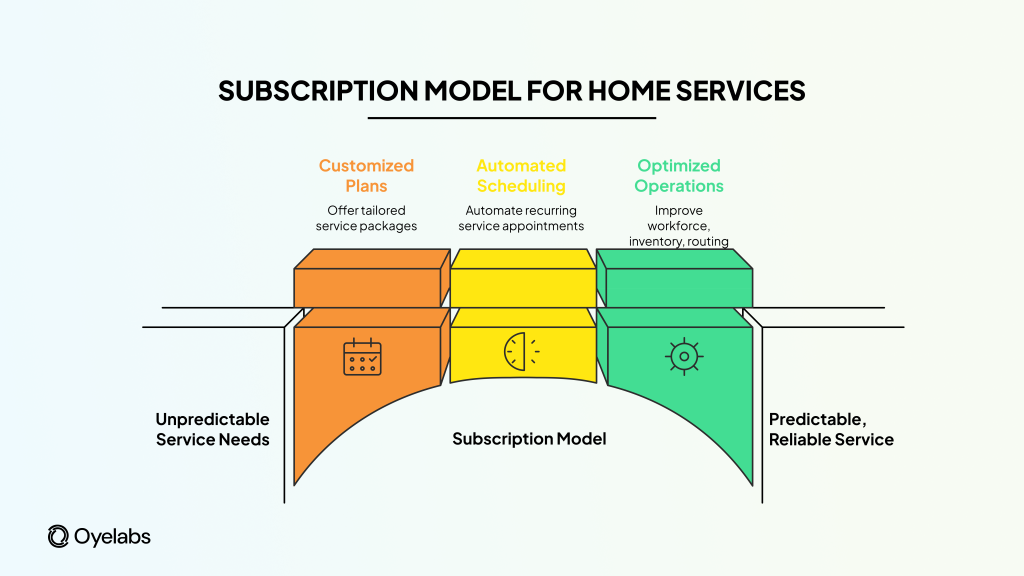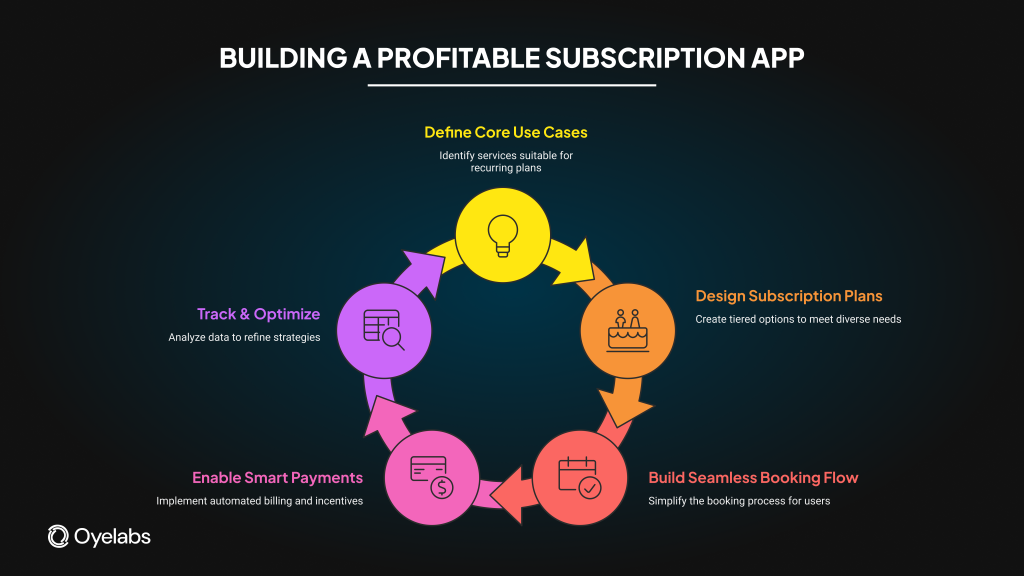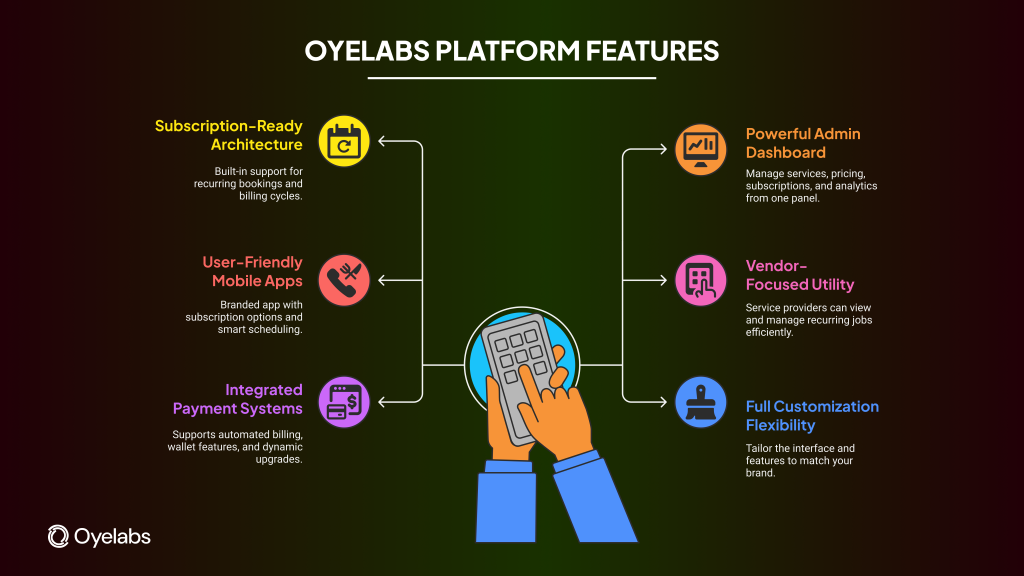Why Subscription Models Are Entering the On-Demand Service Space

Why Subscription Models Are Entering the On-Demand Service Space
Last Updated on August 24, 2025
Subscription-based models are quietly reshaping the on-demand economy. In sectors like home services, where recurring needs are common, this shift is creating powerful advantages, more predictable revenue, higher user retention, and streamlined service operations.
Whether you’re exploring a white-label UrbanClap app or planning to launch your own on-demand home services platform, understanding this shift can unlock stronger unit economics and deeper customer loyalty.
This article breaks down why subscription models are gaining traction, how they align with today’s service expectations, and what it means for anyone looking to build a competitive, future-ready platform in the home services space.
What Is a Subscription Model in On‑Demand Services?
Before we explore why it’s working so well, let’s first define the model through the lens of real-world application, especially for those building or managing a home services platform.
A subscription model allows customers to pay a recurring fee, monthly, quarterly, or annually, in exchange for continued access to a service. In the context of a home services app like UrbanClap, this could mean a weekly cleaning service, bi-weekly appliance maintenance, or a monthly beauty visit, all booked once and managed automatically.
The key difference from one-time service bookings lies in customer lifecycle management. With subscriptions, businesses gain consistent revenue through recurring billing, while customers enjoy a seamless, low-friction experience. This dual benefit increases customer lifetime value (CLV) and reduces customer acquisition cost (CAC) over time.
For entrepreneurs using a white-label UrbanClap app or UrbanClap clone script, incorporating subscription features can also enhance operational efficiency. It allows for better resource planning, improved workforce scheduling, and more predictable revenue forecasting, all critical components in scaling a profitable on-demand home services app.
Unlike e-commerce or SaaS platforms, service marketplaces operate on complex logistics. Integrating subscription logic, such as auto-renewals, usage tiers, pause/resume options, and lifecycle automation, adds a layer of predictability in an otherwise high-variability system. When combined with a robust service booking platform development framework, this model becomes not just viable, but highly scalable.
Why Subscription Models Are Becoming Popular in Home Service Apps
The rise of subscription-based services isn’t just a consumer trend, it’s a structural shift in how service platforms are built and monetized.
In the on-demand home services space, customers are increasingly seeking reliability, routine, and value. From a platform owner’s perspective, subscriptions create monthly recurring revenue (MRR), which improves financial visibility and reduces the volatility typically seen in on-demand businesses. This makes it easier to raise investor confidence, plan staffing needs, and manage performance benchmarks.
Additionally, customer behavior supports the shift. In practical terms, an UrbanClap-style marketplace that offers recurring services becomes more “sticky” in the customer’s daily life, improving retention rates and reducing churn.
Another reason for this shift is the decline in per-transaction loyalty. Customers are more likely to switch platforms if every transaction is standalone. A subscription model fosters ongoing engagement and deeper platform loyalty, especially when personalized offers, referral perks, and service bundles are integrated into the experience. Global subscription economy revenues are projected to surge from $492 billion in 2024 to over $1.5 trillion by 2033, growing at a 13.3% annual rate
So, if you’re looking to build your own on-demand marketplace, offering subscriptions is not a “nice to have”, it’s quickly becoming a competitive requirement.
What Customers Really Want Today, And How Subscription Helps
Today’s service economy is driven by convenience, predictability, and personalization. Customers aren’t just looking for a one-time electrician or a quick facial; they want structured, dependable service they don’t have to think twice about.
they want structured, dependable service they don’t have to think twice about.
For example, a customer may need a deep cleaning every month and general upkeep weekly. Offering a customized plan through your home services marketplace app lets them choose once and automate the rest. This aligns with behavioral data: when given the option to subscribe, users are 2.4x more likely to stay with the platform long-term.
From a business standpoint, this creates predictable usage patterns. Your UrbanClap-like service platform can then optimize workforce management, inventory stocking (cleaning supplies, beauty kits, tools), and route planning, all key metrics in efficient platform operations.
It also builds habitual engagement, which leads to higher customer retention and lower support costs. The result? More value per user, less spend per conversion.
For customers, the value is equally clear: fixed pricing, time saved, and reliable service providers. When managed well, subscriptions elevate your brand from “another service app” to a trusted part of a user’s monthly routine.
Real Benefits of Adding a Subscription to Your UrbanClap‑Like App
Adding subscription logic to your UrbanClap clone solution can dramatically improve platform stability and user engagement. Let’s break down the key benefits, both for platform owners and end users.
Platform Benefits of Subscription-Based Home Services Apps
| Benefit | How It Helps Your Business |
| Predictable Revenue | Generate Monthly Recurring Revenue (MRR) for smoother cash flow. |
| Reduced Churn | Customers stay longer due to lower friction and higher engagement. |
| Better User Retention | Recurring services foster habit and brand attachment. |
| Lower Customer Acquisition Cost (CAC) | Existing subscribers reduce dependency on new user acquisition. |
| Data-Driven Upselling | Use behavior patterns to offer personalized add-ons or upgrades. |
| Optimized Workforce Scheduling | Plan service teams around fixed recurring appointments. |
End User Benefits
- No need to remember or rebook every time
- Consistent quality with same service providers
- Transparent pricing with zero surprise charges
- Flexibility to pause, upgrade, or switch plans
- Loyalty rewards for long-term commitment
Platforms using a subscription-first approach report a 30–45% improvement in user retention compared to pay-per-service models.
Curious to see how other fast-growing platforms are applying this model? Check out our list of the Top On-Demand Services Startups in 2025 to discover who’s leading the charge and why.
Common Challenges (and How to Solve Them Easily)
Integrating subscription features into an on-demand home services app introduces operational complexity, but these are manageable with the right system in place.
Common Roadblocks & Solutions
| Challenge | Solution |
| Customers cancel after one or two uses | Introduce trial periods or minimum commitment tiers |
| Managing schedule changes or rescheduling | Enable flexible time-slot swapping and pause options |
| Billing disputes or confusion | Use automated invoices with transparent breakdowns |
| High demand variation during peak seasons | Offer subscription caps or priority scheduling for premium subscribers |
| Complexity in backend integration | Choose a ready-made UrbanClap script with built-in subscription logic |
What to Include in a Subscription-Ready Platform
- Tiered service plans (Basic, Standard, Premium)
- Automated billing and in-app wallet
- Pause/resume controls for users
- Admin-side dashboards to monitor subscription health
- Service-level analytics: churn rate, plan preference, usage rate
Oyelabs’ white-label UrbanClap app includes all essential modules needed to operate a subscription-based model at scale, from automated billing to custom service tiers.
How to Build a Profitable On-Demand App With Subscription Features

Adding subscriptions isn’t just about recurring payments; it’s about designing the full user journey to encourage long-term value and operational efficiency.
Step-by-Step Setup
Step 1: Define Core Use Cases
Start with high-repeat services:
- Cleaning (weekly/monthly)
- Beauty at home
- Appliance servicing
- Gardening or maintenance
These services naturally lend themselves to recurring plans.
Step 2: Design Subscription Plans
Offer at least 3 tiers to cater to different user needs:
- Lite Plan: Once a month
- Standard Plan: Bi-weekly visits
- Premium Plan: Weekly visits with add-ons (deep cleaning, extra rooms, etc.)
Step 3: Build Seamless Booking Flow
- Show “Subscribe & Save” next to one-time booking
- Allow bundling of services (e.g., cleaning + laundry)
- Include calendar sync and reminders
Step 4: Enable Smart Payments
- Use a wallet or a card for auto-billing
- Incentivize longer-term commitments (e.g., 10% off quarterly plans)
Step 5: Track & Optimize
- Monitor:
- Subscription uptake rate
- Retention rate per plan
- Most popular services
- Use this data to tweak pricing, bundle combinations, and loyalty programs
What Oyelabs Provides
When you use our UrbanClap clone script, we include:
- Full subscription management engine
- Admin-side analytics dashboard
- Pre-integrated payment gateways
- Scalable backend for multi-city expansion
- White-labeled mobile apps for iOS & Android
Why Oyelabs Offers the Right Platform to Start

You don’t need to start from zero to capitalize on the subscription-driven shift in home services. At Oyelabs, we’ve built a white-label UrbanClap app that’s fully equipped to support recurring service models, helping you reduce time-to-market, simplify tech decisions, and scale faster with confidence.
Here’s what sets our UrbanClap clone solution apart:
- Subscription-Ready Architecture: Built-in support for recurring bookings, billing cycles, and flexible plan management, no third-party plugins required.
- Powerful Admin Dashboard: Manage services, pricing tiers, customer subscriptions, churn rates, and platform analytics, all from a single control panel.
- User-Friendly Mobile Apps (iOS & Android): Your customers get a branded app with subscription options, smart scheduling, reminders, and in-app payment capabilities.
- Vendor-Focused Utility: Service providers can view, accept, and manage recurring jobs, ensuring efficiency in high-frequency bookings.
- Integrated Payment Systems: Supports automated billing, wallet features, and dynamic upgrades, crucial for running a modern on-demand home services app.
- Full Customization Flexibility: Tailor the user interface, feature set, and service structure to match your brand vision and local market needs.
With Oyelabs, you’re not just getting a basic UrbanClap clone script. You’re getting a production-ready solution designed to support real-world operations, whether you’re testing in a single city or expanding across regions.
Already trusted by entrepreneurs across the U.S., MENA, and Southeast Asia, our clients use Oyelabs’ platform to launch their home services app with subscription models baked in, driving both growth and user loyalty from day one.
Ready to Launch Your Subscription-Based Home Services App?
If you’re ready to capture recurring revenue, delight your users, and scale your operations, Oyelabs is here to help.
Our white-label UrbanClap app is engineered to support both one-time and subscription-based service models, helping you go to market in under 10 days with a fully functional, branded platform.
Let’s talk about your goals, your target market, and how we can help you build your on-demand marketplace with speed and confidence.
Book a free consultation today.
Let’s turn your home service idea into a recurring-revenue success story.
Final Thoughts: Subscription Isn’t the Future, It’s the Standard
The demand for structured, recurring services is growing across industries, and home services are no exception. For founders looking to build real long-term value with their UrbanClap-like service platform, integrating a subscription model isn’t an optional upgrade; it’s a strategic advantage.
Customers want simplicity. Businesses want predictability. Subscription models serve both.
Platforms that embrace this shift early will benefit from stronger customer lifetime value, lower acquisition costs, and more efficient operations. With the right partner and product foundation, even early-stage founders can compete with market leaders in this space.
The combination of a smart business model and a ready-to-launch solution like Oyelabs’ ready-made UrbanClap script is your shortcut to building a defensible, profitable home services marketplace app.
Frequently Asked Questions
1. Why should I integrate a subscription model into my on-demand home services app?
It improves user retention, creates predictable revenue, and adds long-term value to your marketplace platform.
2. What types of home services work best with a subscription model?
Recurring services like cleaning, pest control, appliance maintenance, and salon-at-home are ideal for subscription plans.
3. Can I start a subscription-based service platform without building from scratch?
Yes, you can use a white-label UrbanClap clone from Oyelabs, which supports built-in subscription features.
4. What’s the biggest challenge of running a subscription model on service platforms?
Managing schedule changes, cancellations, and ensuring consistent service quality across recurring appointments can be complex without automation.




